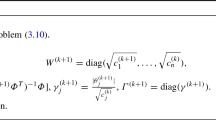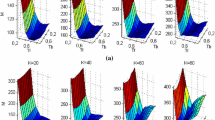Abstract
The present paper focuses on accelerating monotone fast iterative shrinkage–thresholding algorithm (MFISTA) that is popular to solve the basis pursuit denoising problem for sparse recovery. Inspired by a recent work that accelerates MFISTA with line search, we alternatively use a much more effective speed-up option, termed sequential subspace optimization. Furthermore, instead of manually setting the number of previous propagation directions in the subspace beforehand, we propose an adaptive method to set it. Additionally, for approximating the absolute value function, we analyze the superiority of a smooth version used in this paper over the one recommended in a previous work, and give an analytical closed-form expression for the shrinkage operator corresponding to the smooth approximation. The experiments presented here show that the proposed method achieves faster convergence speeds in terms of iteration and run-time.









Similar content being viewed by others
Notes
It is applied to a vector or matrix element-wise.
This is the Lipschitz constant with respect to the gradient of the quadratic term in (1).
The objective function could be non-smooth since the gradient direction is not necessary.
We use the termination criterion (12) as an example for presentation.
When other optimization methods that do not require a smooth objective function are employed for line search, MFISTA-LS can directly solve (1).
\(\mathbf {A}\) is a normal matrix if \(\mathbf {A}^\mathrm{T}\mathbf {A}=\mathbf {A}\mathbf {A}^\mathrm{T}\).
References
Chen, S.S., Donoho, D.L., Saunders, M.A.: Atomic decomposition by basis pursuit. SIAM Rev. 43(1), 129–159 (2001)
Wen, Z., Yin, W., Goldfarb, D., Zhang, Y.: A fast algorithm for sparse reconstruction based on shrinkage, subspace optimization, and continuation. SIAM J. Sci. Comput. 32(4), 1832–1857 (2010)
Figueiredo, M.A., Nowak, R.D., Wright, S.J.: Gradient projection for sparse reconstruction: application to compressed sensing and other inverse problems. IEEE J. Sel. Top. Signal Process. 1(4), 586–597 (2007)
Gu, R., Dogandžić, A.: Projected nesterov’s proximal-gradient algorithm for sparse signal recovery. IEEE Trans. Signal Process. 65(13), 3510–3525 (2017)
Wright, S.J., Nowak, R.D., Figueiredo, M.A.: Sparse reconstruction by separable approximation. IEEE Trans. Signal Process. 57(7), 2479–2493 (2009)
Donoho, D.L., Maleki, A., Montanari, A.: Message-passing algorithms for compressed sensing. Proc. Nat. Acad. Sci. 106(45), 18914–18919 (2009)
Metzler, C.A., Maleki, A., Baraniuk, R.G.: From denoising to compressed sensing. IEEE Trans. Inf. Theory 62(9), 5117–5144 (2016)
Zibulevsky, M., Elad, M.: L1–l2 optimization in signal and image processing. IEEE Signal Process. Mag. 27(3), 76–88 (2010)
Combettes, P.L., Pesquet, J.C.: Proximal splitting methods in signal processing. In: Bauschke, H.H., Burachik, R.S., Combettes, P.L., Elser, V., Russell Luke, D., Wolkowicz, H. (eds.) Fixed-Point Algorithms for Inverse Problems in Science and ngineering, pp. 185–212. Springer, New York, NY, USA (2011)
Parikh, N., Boyd, S.: Proximal algorithms. Found. Trends® Optim. 1(3), 123–231 (2014)
Daubechies, I., Defrise, M., De Mol, C.: An iterative thresholding algorithm for linear inverse problems with a sparsity constraint. Commun. Pure Appl. Math. J. Issued Courant Inst. Math. Sci. 57(11), 1413–1457 (2004)
Beck, A., Teboulle, M.: A fast iterative shrinkage–thresholding algorithm for linear inverse problems. SIAM J. Imaging Sci. 2(1), 183–202 (2009)
Kim, D., Fessler, J.A.: Another look at the fast iterative shrinkage/thresholding algorithm (FISTA). SIAM J. Optim. 28(1), 223–250 (2018)
Beck, A., Teboulle, M.: Fast gradient-based algorithms for constrained total variation image denoising and deblurring problems. IEEE Trans. Image Process. 18(11), 2419–2434 (2009)
Tan, Z., Eldar, Y.C., Beck, A., Nehorai, A.: Smoothing and decomposition for analysis sparse recovery. IEEE Trans. Signal Process. 62(7), 1762–1774 (2014)
Bioucas-Dias, J.M., Figueiredo, M.A.: A new twist: two-step iterative shrinkage/thresholding algorithms for image restoration. IEEE Trans. Image Process. 16(12), 2992–3004 (2007)
Yamagishi, M., Yamada, I.: Over-relaxation of the fast iterative shrinkage–thresholding algorithm with variable stepsize. Inverse Prob. 27(10), 105008 (2011)
Zibetti, M.V., Helou, E.S., Migueles, E.X., De Pierro, A.R.: Accelerating the over-relaxed iterative shrinkage-thresholding algorithms with fast and exact line search for high resolution tomographic image reconstruction. In: 2015 IEEE International Conference on Image Processing (ICIP), pp. 2305–2308. IEEE, Quebec (2015)
Zibetti, M.V., Helou, E.S., Pipa, D.R.: Accelerating over-relaxed and monotone fast iterative shrinkage–thresholding algorithms with line search for sparse reconstructions. IEEE Trans. Image Process. 26(7), 3569–3578 (2017)
Mouatasim, A.E.: Control proximal gradient algorithm for image l1 regularization. SIViP 13(6), 1113–1121 (2019)
Nocedal, J., Wright, S.: Numerical Optimization. Springer, Berlin (2006)
Narkiss, G., Zibulevsky, M.: Sequential subspace optimization method for large-scale unconstrained optimization. Technion, Israel Institute of Technology, Haifa, technical report CCIT 559 (2005)
Zibulevsky, M.: Speeding-up convergence via sequential subspace optimization: current state and future directions. arXiv:1401.0159 (2013)
Donoho, D.L.: De-noising by soft-thresholding. IEEE Trans. Inf. Theory 41(3), 613–627 (1995)
Sadeghi, M., Babaie-Zadeh, M.: Iterative sparsification-projection: fast and robust sparse signal approximation. IEEE Trans. Signal Process. 64(21), 5536–5548 (2016)
Donoho, D.L.: Compressed sensing. IEEE Trans. Inf. Theory 52(4), 1289–1306 (2006)
Vehkaperä, M., Kabashima, Y., Chatterjee, S.: Analysis of regularized LS reconstruction and random matrix ensembles in compressed sensing. IEEE Trans. Inf. Theory 62(4), 2100–2124 (2016)
Mallat, S.: A Wavelet Tour of Signal Processing—The Sparse Way, 3rd edn. Elsevier, Burlington (2009)
Author information
Authors and Affiliations
Corresponding author
Additional information
Publisher's Note
Springer Nature remains neutral with regard to jurisdictional claims in published maps and institutional affiliations.
Rights and permissions
About this article
Cite this article
Zhu, T. Accelerating monotone fast iterative shrinkage–thresholding algorithm with sequential subspace optimization for sparse recovery. SIViP 14, 771–780 (2020). https://doi.org/10.1007/s11760-019-01603-4
Received:
Revised:
Accepted:
Published:
Issue Date:
DOI: https://doi.org/10.1007/s11760-019-01603-4




